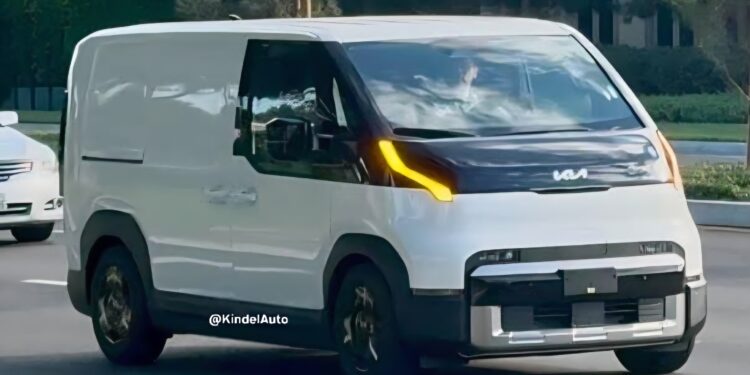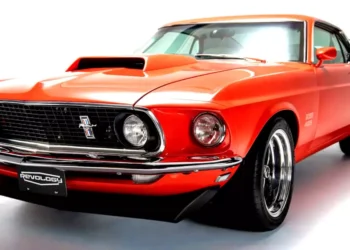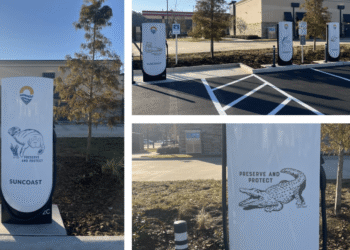Kia’s electric van, the PV5, was recently observed during testing in California featuring distinctive orange daytime running lights (DRLs), as captured by our colleagues at KindelAuto — indicating that the company could be eyeing a U.S. market entry. Amid rising interest in electric vehicles (EVs), particularly for commercial use, ride-hailing, and fleet operations, the PV5 might address a key gap. However, numerous regulatory, financial, and strategic barriers persist. This piece examines the available details, the implications of this sighting, and the realistic prospects for a U.S. debut.
What Is the Kia PV5?
Prior to exploring U.S. potential, let’s review the essentials of the Kia PV5:
- The PV5 is a Purpose-Built Vehicle (PBV) developed by Kia using its innovative E-GMP.S (service) platform.
- It offers various configurations: a passenger model, cargo van, chassis cab, wheelchair-accessible version (WAV), and conceptual options such as “Light Camper,” “Open Bed,” and “Robotaxi” styles.
Battery choices encompass a 51.5 kWh or 71.2 kWh unit for most variants; a compact 43.3 kWh pack (with an alternative chemistry) is offered for the cargo model. The maximum range under Europe’s WLTP standard reaches approximately 248 miles for the passenger variant with the bigger battery. In U.S. EPA testing, this figure could be lower.
What the California Spotting Means
The latest observation of the PV5 in testing across California and Arizona yields valuable insights:
- Regulatory and environmental evaluations
California enforces rigorous standards for environmental factors (like heat, emissions, and battery thermal management), so trials here imply Kia is verifying performance in challenging scenarios. - Charging system alignment
Real-world U.S. charging tests (including port compatibility and heat dissipation) are common in these areas. Presence in California points to efforts to align with American EV infrastructure. - Market indication
Companies frequently prototype in target markets. Testing in California often hints at future plans or viability checks, though a single sighting doesn’t guarantee a release. Kia hasn’t announced official U.S. plans.
Key Challenges to U.S. Launch
Despite the ongoing tests, substantial issues could hinder, restrict, or prevent a comprehensive U.S. introduction. The primary concerns include:
- Tariffs and Import Fees
The U.S. levies steep duties on imported light trucks and commercial vans — infamously called the “Chicken Tax” at 25%. As a van/PBV, the PV5 might face these significant costs. - Regulatory Compliance
For U.S. sales, it must satisfy national safety, emissions, and efficiency rules from agencies like NHTSA, EPA, and California’s CARB. Aligning a vehicle designed for European and Korean specs with U.S. requirements may necessitate costly changes and timelines. - Battery and Range Validation
EPA estimates are typically stricter than WLTP figures. Kia’s 248-mile WLTP claim might shrink under EPA scrutiny, and buyers could demand strong charging capabilities (such as rapid DC options). - Incentives and Tax Benefits
Under the Inflation Reduction Act (IRA), eligibility for credits depends on local sourcing, battery materials, and assembly location. Failure to comply could exclude the PV5 from buyer incentives, impacting its appeal. - Manufacturing and Logistics
Production is currently in South Korea. Without U.S.-based facilities or tariff-avoiding import strategies, pricing could remain uncompetitive in the American market.
Conclusion
The appearance of Kia PV5 prototypes in California testing isn’t random — it probably signifies preparations for U.S. viability. While consumer availability isn’t assured, indicators suggest 2026 as a potential timeframe, particularly for business uses. Tariffs, compliance, and affordability continue to pose the greatest risks.






![Lucid Motors launches Gravity Touring SUV, starting below $80,000 [Video]](https://thecruisectrlr.com/wp-content/uploads/2025/11/Lucid-Gravity-Touring-Hero-350x250.jpg)




